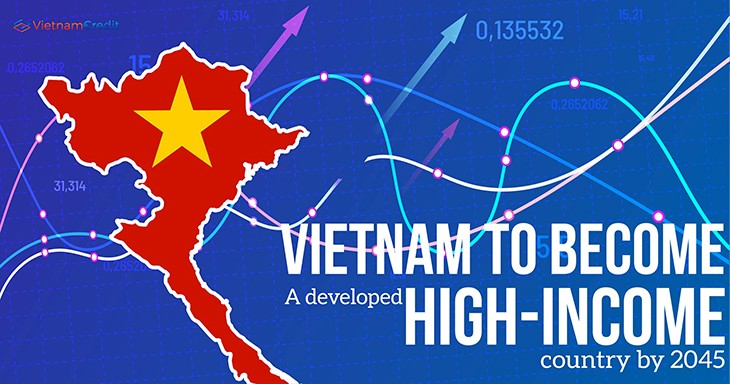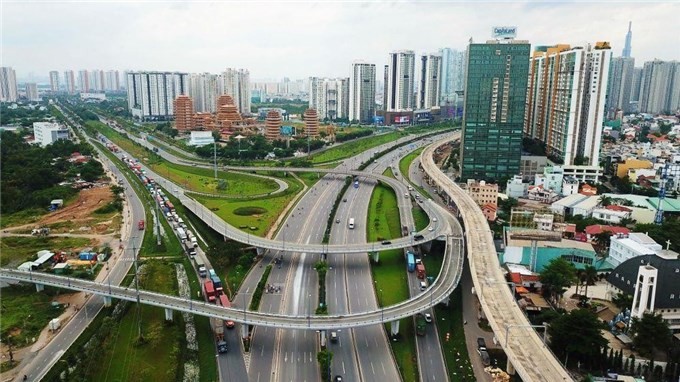
Realising the aspiration to be a developed, upper-middle-income Viet Nam
Latest
The Resolution of the 13th National Party Congress underlined the overall goals and concrete targets for 2030 and 2045. By 2030, which is the 100th anniversary of the founding of the Communist Party of Viet Nam, the country set its sight to become a developing, modern industrialized, upper-middle-income country. By 2045, at the 100th anniversary of the establishment of the Democratic Republic of Viet Nam, now the Socialist Republic of Viet Nam, it will be a developed high-income country.
 |
| Viet Nam aims to become a developed, upper-middle-income country. (Photo: Vietnam Credit) |
The ten-year Socio-economic development strategy (2021-2030 period) also sets similar goals. Besides, Viet Nam strives for 7.500 USD per capita GDP by 2030. In the next 5 years (2021-2025), Viet Nam sets the average economic growth rate (GDP) at about 6.5-7%/year. By 2025, the per capita GDP will be about 4,700-5,000 USD.
Promising goals
With an average economic growth rate of 6.84%/year from 2016-2020, in which, the growth reached 7.08% and 7.02% in 2018 and 2019 respectively, Viet Nam entered the period 2021-2025 with a number of prospects.
In fact, over 35 years of Doi moi (reform), especially in the last 20 years, Viet Nam has clearly demonstrated its potentials. From a poor and slowly-developed country, Viet Nam’s economy has entered a new stage of development. Now, Viet Nam is the 4th largest economy in terms of GDP in the Association of Southeast Asian Nations, moving forward in a series of global prestigious rankings.
As State President Nguyen Xuan Phuc said at the national conference popularising resolution of 13th National Party Congress that, after 35 years of Doi moi, the country has achieved great achievements of historical significance. Viet Nam’s GDP now totals USD 343 billion, ranking 37th over the world. It is also one of the 16 emerging economies, among the 10 fastest growing countries, and standing forth in ASEAN in terms of per capita GDP.
From an embargoed country, Viet Nam today has established diplomatic relations with 189/193 member countries of the United Nations, had economic, trade and investment relations with over 224 countries and territories.
According to Dr. Vu Minh Khuong, Associate Professor at the Lee Kuan Yew School of Public Policy (National University of Singapore), to be come a developed country by 2045 when celebrating the 100th anniversary of independence, Viet Nam will be written down in the mandkine history as a miraculous development story. That is, within just 100 years, a nation can pass all three stages: "stand up", "wake up" and "rise up".
From 1945-1975, Viet Nam unanimously “stood up” to break out of the chains of slavery and poverty, and fight to regain independence and freedom.
In the period 1975-2015, the whole country pondered and "woke up" to find a way to rise from poverty and outdated thinking with the first course of Doi moi (1986-2015). This helped Viet Nam to take a major step forward, in terms of both position and influence.
The “rise up” period happened after the 12th National Party Congress in 2016 with the second wave of Doi moi, raising the expectation of bringing the country to prosperity and strength by 2045.
In the first 5 years of this journey, especially in 2020, Viet Nam has made impressive feats, scoring points in the world both in terms of economic growth and experience in preventing the Covid-19 pandemic.
To achieve such great and historically significant achievements is largely thanks to the comprehensive reform of the country, initiated and led by the Party, including guidelines and policies on innovation and application of science-technology.
 |
| Viet Nam needs to have the determination to implement some strategic changes. (Photo: Bao Phap Luat) |
Making strategic changes to realize goals
To accomplish the set goals, the documents of the 13th National Party Congress identify three directions and tasks for socio-economic development in the 2021-2030 period. These are: Focusing on perfecting and improving the quality of the institution of the socialist-oriented market economy; developing science, technology and innovation; strengthening economic restructuring in association with renovating the growth model.
Also, the 10-year Socio-economic development strategy (2021-2030 period), the percentage of enterprises with technology innovation will reach 40% by 2030.
According to Prof. Ha Ton Vinh, former White House Assistant in the first Reagan administration, there are still a lot of challenges for Viet Nam in the years to come. However, with past experience and current development momentum, Viet Nam will enter a new era with a more sustainable and spectacular development path than what it has done in the past 35 years.
"The 13th National Party Congress gave me confidence and hope in the country's determination to maintain socio-political stability and economic reform, especially in the governance and administration”, Prof. Vinh said.
Prof. Ha Ton Vinh said that Viet Nam needs to have the determination and immediately implement some strategic changes.
Firstly, it is necessary to have a national investment policy and to develop technology and science to make a transition to a digital economy, like the previous policy that was used to convert the centralized economy to market economy in 1986.
The digital transformation revolution will be like the internet and computer revolution in the 80s and 90s of the last century. Everyone is affected and no one is allowed to stand outside the influence of computer technology and the internet-connected world.
Secondly, there must be breakthroughs in finding, training, using, and maintaining highly qualified workforce, suitable for the development of the digital economy. In today's "flat world", technology and what we learned yesterday will no longer be a competitive advantage.
Newly trained talent will advance faster and further than those of yesterday's generation. Success or failure will be determined by the development of technology and the transformation of management and operation of the digital economy.
Third, continue to promote the change and adjustment of the operating mechanism towards a true market economy, and to boost widespread and sustainable growth with cooperation and international integration.
Viet Nam needs to prioritize the strengths of each locality like maritime, mining, tourism, creating an economic alliance between businesses and local governments, or public-private partnership projects.
“The road ahead is long and difficult. But the country will eventually go through. The strong determination of the country’s leaders and the business community will be a prerequisite for Viet Nam to achieve its goals in 2030 and 2045, which were set out in the Resolution of the 13th National Party Congress”, affirmed Prof. Vinh.
























